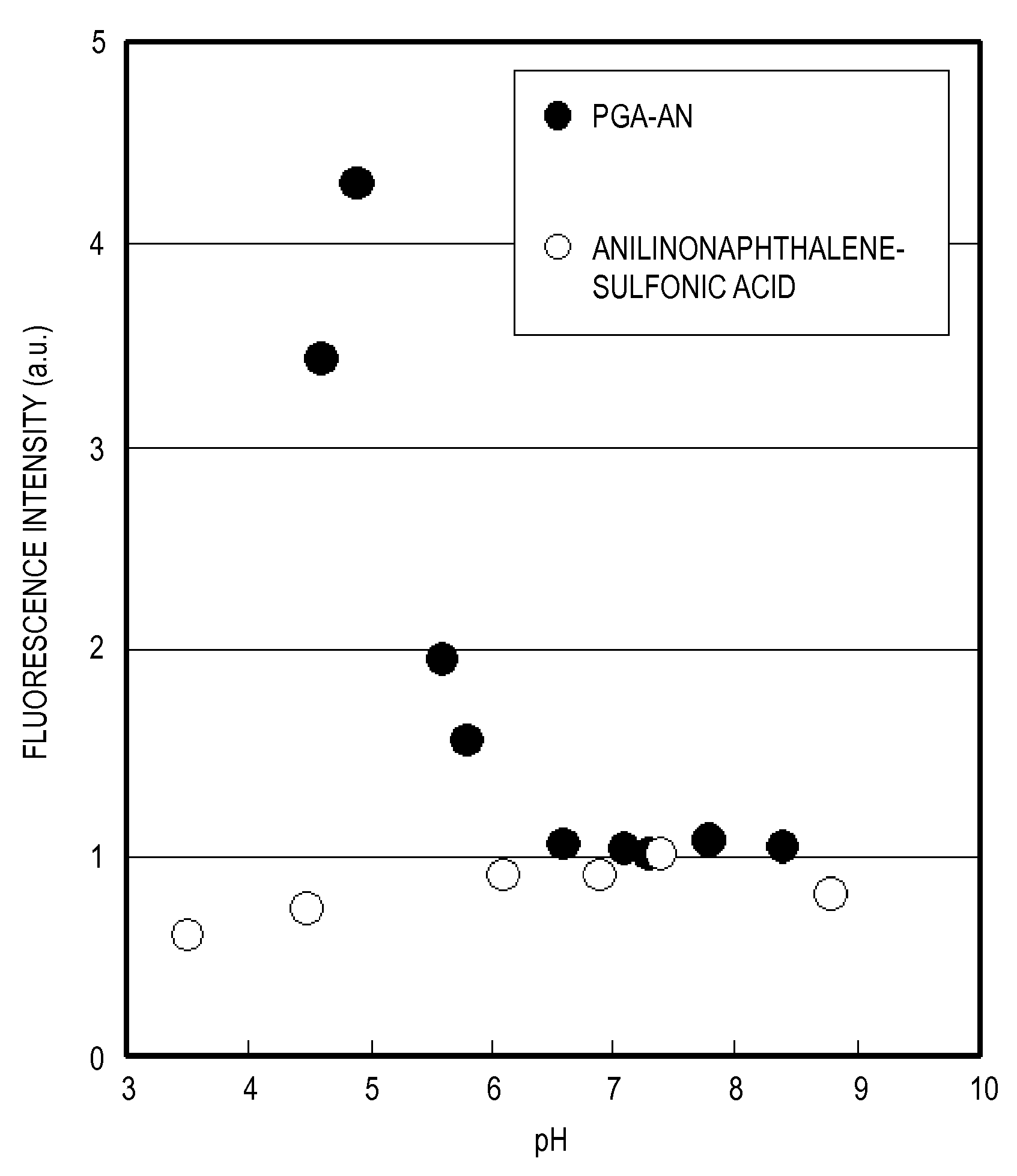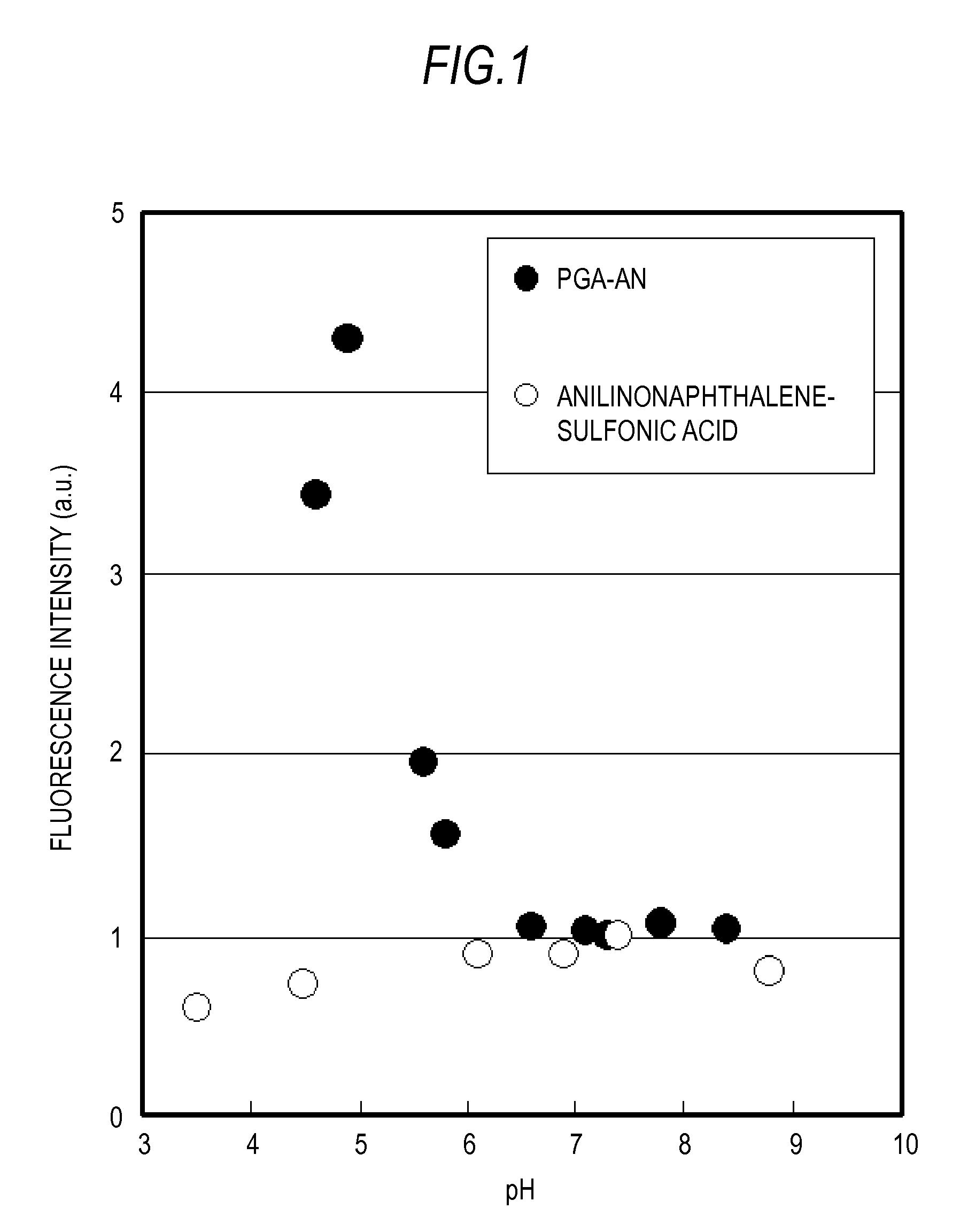Polymer and fluorescence probe having the polymer
a fluorescence probe and polymer technology, applied in the field of new polymer and fluorescence probe, can solve the problems of difficult detection of low-ph sites, difficult to discriminate between the decrease, and decrease in fluorescence intensity
- Summary
- Abstract
- Description
- Claims
- Application Information
AI Technical Summary
Benefits of technology
Problems solved by technology
Method used
Image
Examples
example 1
Synthesis of Polymer
Example 1-1
[0063]Succinimidization of poly-L-glutamic Acid
[0064]A total of 1 g of a sodium salt of poly-L-glutamic acid (PGA; Mw 41,000, Peptide Research Institute) was dissolved in 100 mL of distilled water, then stirring was conducted, while dropwise adding hydrochloric acid, and desalinated PGA was precipitated. The obtained desalinated PGA was thoroughly washed with acetone, washed with ether, and then vacuum dried. The washed and dried PGA (150 mg) was then dissolved in 1 mL of anhydrous DMSO, N-hydroxysuccinimide (NHS; 13.5 mg) and 1-ethyl-3-dimethylaminopropylcarbodiimide hydrochloride (EDC; 22.2 mg) were added, and then shaking was conducted overnight at room temperature. A 10% succinimidization was conducted with respect to the entire COOH in the charging ratio. After the reaction, reprecipitation was performed using anhydrous acetone in order to remove the unreacted EDC and 1-ethyl-3-(3-dimethylaminopropyl) urea, which is a reaction after-product of NHS...
example 1-2
[0065]Modification of Succinimidized PGA with Anilinonaphthylimide
[0066]The succinimidized PGA (150 mg) prepared according to the above-described Example 1-1 was dissolved in anhydrous DMSO (5 mL). Then, N-(1-anilinonaphthyl-4-)-maleimido (anilinonaphthylimide: ANM) (21 mg) and 6-amino-1-hexanethiol (11 mg) were mixed, the DMSO solution, 1.5 mL, that was stirred overnight was added, and stirring was conducted overnight at room temperature in a dark room. The reaction solution was reprecipitated using acetone was then washed twice by decantation. Washing with hexane, ether substitution, and vacuum drying were then conducted to obtain 136 mg of anilinonaphthylmaleimide-modified PGA (PGA-AN1) (yield 90%). The modification ratio (n / n+m) of the AN group with respect to the entire COOH of the PGA was confirmed to be 0.006 by measuring the absorbance (350 nm) of and anilinonaphthyl (AN) group of the obtained PGA-AN1. The structural formula of the obtained PGA-AN1 is shown in Formula 3 abov...
example 1-3
[0068]Modification of Succinimidized PGA with 9-Diethylamino-2-hydroxy-5H-benz[a]phenoxazin-5-one
[0069]The succinimidized PGA (150 mg) prepared according to Example 1-1 was dissolved in anhydrous DMSO (5 mL), 9-Diethylamino-2-hydroxy-5H-benz[a]phenoxazin-5-one (DEAHB), 20 mg, which is a Nile Red derivative, was mixed with the solution, and stirring was conducted overnight at room temperature in a dark room. The reaction liquid was reprecipitated with acetone and washed twice by decantation. Washing with hexane, ether substitution, and vacuum drying were then conducted to obtain 116 mg of DEAHB-modified PGA (PGA-NR) (yield 76%). The modification ratio of the DEAHB group with respect to the entire COOH of the PGA was confirmed to be 0.002 by measuring the absorbance (600 nm) of and DEAHB group of the obtained PGA-NR. The structural formula of the obtained PGA-NR is shown in Formula 4 above. In this formula m was 317 and n was 0.6.
PUM
| Property | Measurement | Unit |
|---|---|---|
| Acidity | aaaaa | aaaaa |
| Acidity | aaaaa | aaaaa |
| Hydrophobicity | aaaaa | aaaaa |
Abstract
Description
Claims
Application Information
 Login to View More
Login to View More - R&D
- Intellectual Property
- Life Sciences
- Materials
- Tech Scout
- Unparalleled Data Quality
- Higher Quality Content
- 60% Fewer Hallucinations
Browse by: Latest US Patents, China's latest patents, Technical Efficacy Thesaurus, Application Domain, Technology Topic, Popular Technical Reports.
© 2025 PatSnap. All rights reserved.Legal|Privacy policy|Modern Slavery Act Transparency Statement|Sitemap|About US| Contact US: help@patsnap.com



